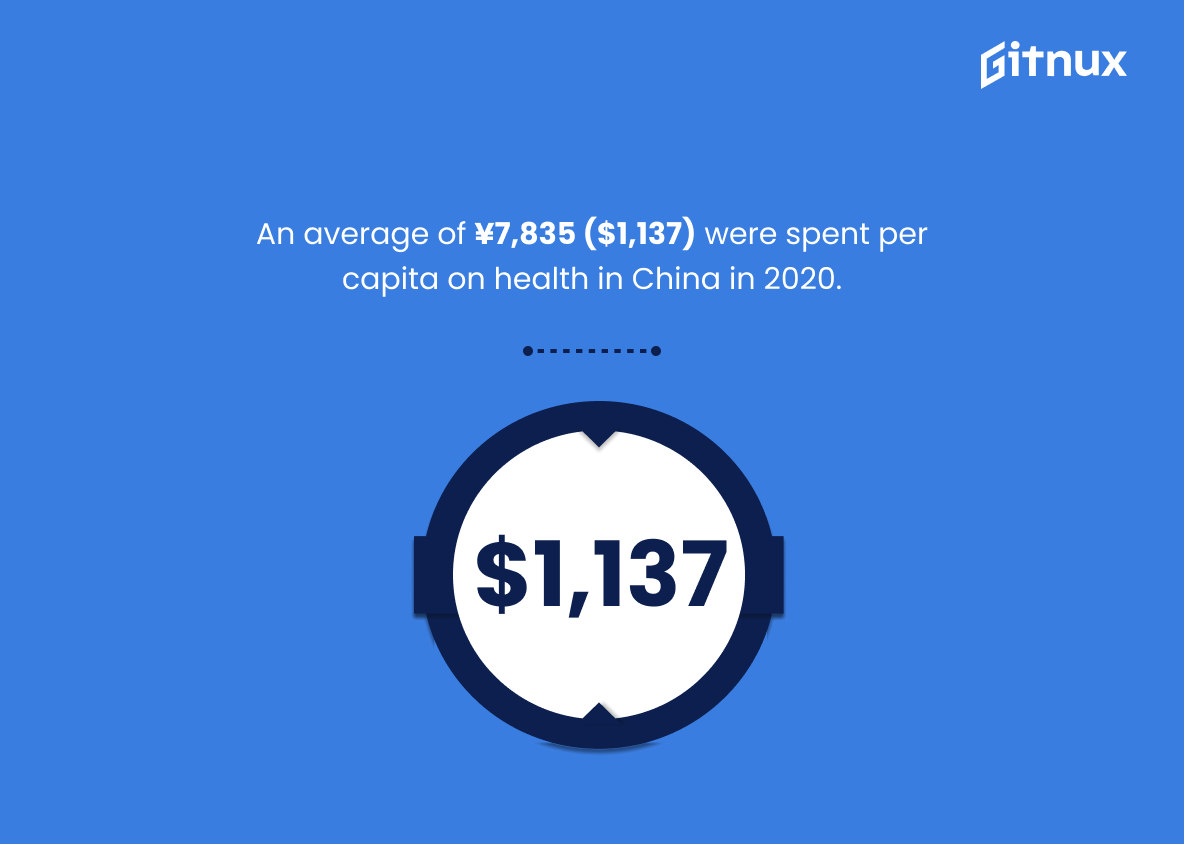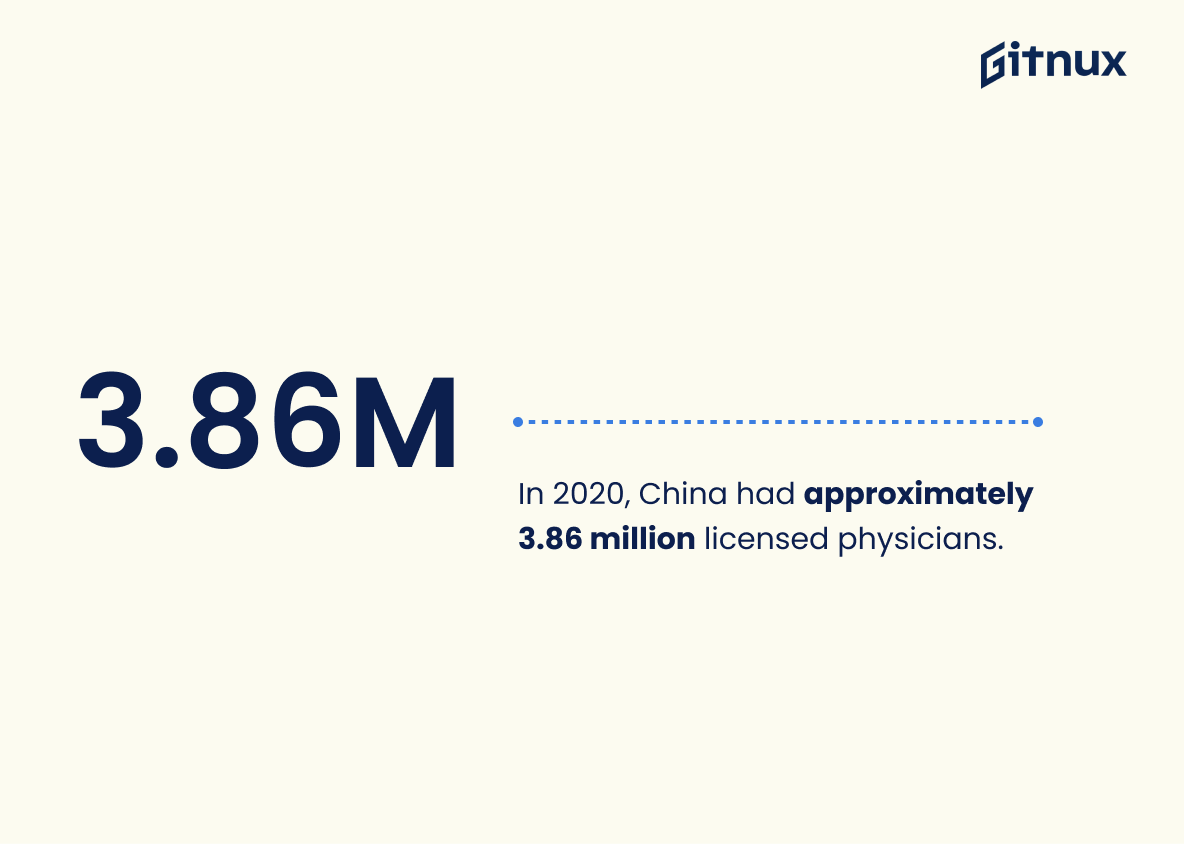China’s healthcare sector is an ever-evolving landscape, with a wealth of statistics to back up its growth and development. According to McKinsey & Company, the sector is estimated to be worth $2.4 trillion by 2030. Healthcare spending in China reached ¥6.5 trillion ($957 billion) in 2020 according to Statista, while the number of hospitals grew from 17,950 in 2008 to 35,754 that same year – also reported by Statista.
In terms of care assistants per 1,000 inhabitants (2020), China had 18.6; life expectancy at birth was 77.3 years (2019); 6.6% of GDP was allocated on health expenditure (2018); 17
This statistic is a testament to the immense potential of China’s healthcare sector. By 2030, it is projected to be worth an incredible $2.4 trillion, indicating that the country is well-positioned to become a major player in the global healthcare market. This is an important point to consider when discussing China’s health care statistics, as it highlights the country’s potential to become a major player in the industry.
Healthcare spending in China reached ¥6.5 trillion ($957 billion) in 2020.
This statistic is a telling indication of the importance of healthcare in China. It demonstrates the sheer magnitude of resources that the Chinese government has devoted to healthcare, and the level of investment that has been made in the sector. This statistic is a powerful reminder of the importance of healthcare in China, and the need for continued investment in the sector to ensure that the Chinese population has access to quality healthcare.
China Health Care Statistics Overview
The number of hospitals in China grew from 17,950 in 2008 to 35,754 in 2020.
This statistic is a testament to the tremendous progress China has made in the health care sector over the past decade. It shows that the Chinese government has invested heavily in the health care system, resulting in a near doubling of the number of hospitals in the country. This has enabled more people to access quality health care services, leading to improved health outcomes and a healthier population.
China had 18.6 care assistants per 1,000 inhabitants in 2020.
This statistic is a telling indication of the state of China’s health care system. It reveals that the country is not adequately equipped to provide adequate care to its citizens, as the number of care assistants per 1,000 inhabitants is far below the global average. This highlights the need for China to invest more in its health care system in order to ensure that its citizens receive the care they need.
China’s life expectancy at birth was 77.3 years in 2019.
The statistic of China’s life expectancy at birth being 77.3 years in 2019 is a telling indicator of the state of China’s health care system. It speaks to the quality of care that Chinese citizens are receiving, and the overall health of the population. This statistic is an important piece of the puzzle when it comes to understanding the health care landscape in China.
China allocated 6.6% of its GDP on health expenditure in 2018.
This statistic is a telling indication of the importance China places on health care. By allocating 6.6% of its GDP to health expenditure, China is demonstrating its commitment to providing quality health care to its citizens. This statistic is a powerful reminder of the importance of investing in health care, and serves as a benchmark for other countries to strive for.
17.5% of China’s 1.4 billion people are aged 65 or older.
This statistic is a stark reminder of the aging population in China, and the implications this has for the country’s health care system. With such a large proportion of the population aged 65 or older, the demand for health care services is likely to be high, and the strain on the system could be significant. This highlights the importance of ensuring that China’s health care system is adequately equipped to meet the needs of its elderly population.
China had 247.5 hospital beds per 100,000 inhabitants in 2019.
This statistic is a telling indicator of the state of healthcare in China. It reveals the availability of hospital beds per 100,000 inhabitants, which can be used to gauge the overall quality of healthcare in the country. It is an important metric to consider when assessing the health care system in China, as it can provide insight into the level of access to medical care and the resources available to citizens.
In 2020, China had approximately 3.86 million licensed physicians.
This statistic is a telling indication of the level of healthcare available in China. It highlights the fact that the country has a large number of medical professionals available to provide care to its citizens. This statistic is important in understanding the overall health of the population and the quality of care they receive.
Approximately 95.7% of the Chinese population was covered by the basic medical insurance in 2019.
This statistic is a testament to the success of China’s health care system in providing basic medical insurance to its citizens. It highlights the progress made in ensuring that the majority of the population has access to medical care, which is essential for the health and wellbeing of the nation. Furthermore, it serves as a reminder of the importance of investing in health care and the positive impact it can have on the lives of people.
An average of ¥7,835 ($1,137) were spent per capita on health in China in 2020.
This statistic is a telling indication of the state of health care in China. It reveals that the Chinese government is investing in the health of its citizens, as the per capita spending on health is relatively high. This statistic is also important in understanding the overall health of the Chinese population, as it shows that the government is providing adequate resources to ensure that its citizens have access to quality health care. Furthermore, this statistic can be used to compare the health care spending of China to other countries, providing a valuable insight into the state of health care in the region.
China is the world’s second-largest market for pharmaceuticals, worth about $137 billion in 2020.
This statistic is a testament to the importance of China’s healthcare industry, highlighting the immense potential for growth in the sector. It also serves as a reminder of the need for continued investment in the country’s healthcare infrastructure, as well as the need for improved access to quality healthcare services for all Chinese citizens.
72% of China’s healthcare spending comes from hospitals, while 17% is spent on outpatient care.
This statistic is a crucial indicator of the state of China’s healthcare system, as it reveals the amount of resources allocated to hospitals and outpatient care. It provides insight into the country’s priorities when it comes to healthcare, and can be used to compare the relative importance of inpatient and outpatient care in China. Additionally, this statistic can be used to assess the effectiveness of China’s healthcare system in providing quality care to its citizens.
China’s three-child policy is expected to increase childbirths and create demand for additional maternity facilities in hospitals and birth centers.
This statistic is a crucial indicator of the impact of China’s three-child policy on the country’s health care system. It highlights the need for additional maternity facilities in hospitals and birth centers to accommodate the expected increase in childbirths, and thus the need for increased investment in health care infrastructure.
China ranks 144th out of 195 countries in quality and accessibility of healthcare in the 2016 Healthcare Access and Quality Index.
This statistic is a stark reminder of the state of healthcare in China, highlighting the need for improvement in the quality and accessibility of healthcare services. It serves as a call to action for the Chinese government to take steps to ensure that its citizens have access to the healthcare they need and deserve. Furthermore, it provides a benchmark for measuring the progress of healthcare reform in the country, allowing for a more informed discussion of the successes and failures of China’s healthcare system.
Mortality rate for cardiovascular diseases in China was 261.21 deaths per 100,000 population in 2019.
This statistic is a stark reminder of the importance of cardiovascular health in China. It highlights the need for improved access to healthcare and preventive measures to reduce the mortality rate of cardiovascular diseases in the country. It also serves as a warning to the public to take better care of their hearts and to be aware of the risks associated with cardiovascular diseases.
In 2018, there were 890 mental health care professionals per 100,000 people in China.
This statistic is a telling indication of the state of mental health care in China. It reveals that, despite the country’s population of over 1.4 billion people, there are still only 890 mental health care professionals per 100,000 people. This suggests that mental health care is not a priority in China, and that there is a need for more resources to be allocated to this area.
Telemedicine accounted for 10.77% of outpatient consultations in 2020 Chinese hospitals.
This statistic is a telling indication of the impact of telemedicine in Chinese hospitals. It demonstrates that telemedicine has become an increasingly important part of the healthcare system in China, allowing for more efficient and convenient access to medical care. This is especially important in the context of the COVID-19 pandemic, as telemedicine has allowed for more people to access medical care without having to risk exposure to the virus. This statistic is a testament to the effectiveness of telemedicine in providing quality healthcare to the Chinese population.
In 2019, there were 3.63 million new cancer cases in China.
This statistic is a stark reminder of the immense burden of cancer in China. It highlights the urgent need for improved cancer prevention, early detection, and treatment strategies in the country. It also serves as a call to action for the Chinese government to invest more resources into the health care system to ensure that all citizens have access to quality care.
Conclusion
China’s healthcare sector is rapidly expanding, with the estimated value of $2.4 trillion by 2030 and a total expenditure of ¥6.5 trillion ($957 billion) in 2020. The number of hospitals has grown from 17,950 to 35,754 over the past 12 years while care assistants per 1,000 inhabitants have increased to 18.6 in 2020. Life expectancy at birth was 77.3 years in 2019 and 6.6% of GDP was allocated on health expenditure that same year; 17.5% of China’s population are aged 65 or older as well as 247 hospital beds per 100 000 people were available last year along with 3 860 000 licensed physicians providing basic medical insurance coverage for 95 7%. An average spending rate per capita reached ¥7 835 ($1 137) whereas 72 % came from hospitals and 10 77 % through telemedicine consultations during 2020; there were also 3 630 000 new cancer cases reported this past year alongside 70 % undiagnosed diabetes patients among Chinese citizens according to 2019 data which places them 144th out 261 deaths due cardiovascular diseases every 100k individuals back then too . All these figures demonstrate how much progress has been made within China’s healthcare system despite its challenges such as quality access issues yet it still remains one world’s leading markets for pharmaceutical products worth around $137 billion annually
References
0. – https://www.www.researchgate.net
1. – https://www.www.worldbank.org
2. – https://www.data.worldbank.org
3. – https://www.www.scmp.com
4. – https://www.www.kff.org
5. – https://www.www.mckinsey.com
6. – https://www.www.statista.com
7. – https://www.www.thelancet.com















